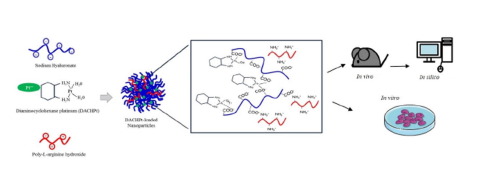当前位置:
X-MOL 学术
›
Eur. J. Pharm. Biopharm.
›
论文详情
Our official English website, www.x-mol.net, welcomes your
feedback! (Note: you will need to create a separate account there.)
Bioinspired hyaluronic acid and polyarginine nanoparticles for DACHPt delivery.
European Journal of Pharmaceutics and Biopharmaceutics ( IF 4.4 ) Pub Date : 2020-02-27 , DOI: 10.1016/j.ejpb.2020.02.008 Kevin Matha 1 , Giovanna Lollo 2 , Giuseppe Taurino 3 , Renaud Respaud 4 , Ilaria Marigo 5 , Molood Shariati 6 , Ovidio Bussolati 3 , An Vermeulen 7 , Katrien Remaut 6 , Jean-Pierre Benoit 1
European Journal of Pharmaceutics and Biopharmaceutics ( IF 4.4 ) Pub Date : 2020-02-27 , DOI: 10.1016/j.ejpb.2020.02.008 Kevin Matha 1 , Giovanna Lollo 2 , Giuseppe Taurino 3 , Renaud Respaud 4 , Ilaria Marigo 5 , Molood Shariati 6 , Ovidio Bussolati 3 , An Vermeulen 7 , Katrien Remaut 6 , Jean-Pierre Benoit 1
Affiliation

|
This work provides insights over a novel biodegradable polymeric nanosystem made of hyaluronic acid and polyarginine for diaminocyclohexane-platinum (DACHPt) encapsulation. Using mild conditions based on ionic gelation technique, monodispersed blank and DACHPt-loaded nanoparticles (NP) with a size of around 200 nm and negative ζ potential (-35 mV) were obtained. The freeze-drying process was optimized to improve the stability and shelf-life of the developed nanoparticles. After reconstitution, nanoparticles maintained their size showing an association efficiency of around 70 % and a high drug loading (8%). In vitro cytotoxicity studies revealed that DACHPt-loaded nanoparticles had a superior anticancer activity compared with oxaliplatin solution. The IC50 was reduced by a factor of two in HT-29 cells (IC50 39 µM vs 74 µM, respectively), and resulted almost 1.3 fold lower in B6KPC3 cells (18µM vs 23µM respectively). Whereas toxic effects of both drug and DACHPt-loaded nanoparticles were comparable in the A549 cell line (IC50 11 µM vs 12 µM). DACHPt-loaded nanoparticles were also able to modulate immunogenic cell death (ICD) in vitro. After incubation with B6KPC3 cells, an increase in HMGB1 (high-mobility group box 1) production associated with ATP release occurred. Then, in vivo pharmacokinetic studies were performed after intravenous injection (IV) of DACHPt-loaded nanoparticles and oxaliplatin solution in healthy mice (35.9 µg of platinum equivalent/mouse). An AUC six times higher (24 h*mg/L) than the value obtained following the administration of oxaliplatin solution (3.76 h*mg/L) was found. Cmax was almost five times higher than the control (11.4 mg/L for NP vs 2.48 mg/L). Moreover, the reduction in volume of distribution and clearance clearly indicated a more limited tissue distribution. A simulated repeated IV regimen was performed in silico and showed no accumulation of platinum from the nanoparticles. Overall, the proposed approach discloses a novel nano-oncological treatment based on platinum derivative with improved antitumor activity in vitro and in vivo stability as compared to the free drug.
中文翻译:

生物启发性的透明质酸和聚精氨酸纳米颗粒,用于DACHPt递送。
这项工作提供了由透明质酸和聚精氨酸制成的新型可生物降解聚合物纳米系统的见解,用于二氨基环己烷-铂(DACHPt)封装。在基于离子凝胶技术的温和条件下,获得了单分散的空白颗粒和DACHPt负载的纳米颗粒(NP),其大小约为200 nm,ζ电势为负(-35 mV)。优化了冷冻干燥过程以改善所开发的纳米颗粒的稳定性和保质期。重构后,纳米粒子保持其大小,显示出约70%的缔合效率和高载药量(8%)。体外细胞毒性研究表明,与奥沙利铂溶液相比,载有DACHPt的纳米颗粒具有优异的抗癌活性。在HT-29细胞中,IC50降低了两倍(IC50分别为39 µM对74 µM),并导致B6KPC3细胞降低近1.3倍(分别为18µM和23µM)。而在A549细胞系中,药物和DACHPt纳米颗粒的毒性作用相当(IC50为11 µM对12 µM)。加载DACHPt的纳米颗粒还能够在体外调节免疫原性细胞死亡(ICD)。与B6KPC3细胞孵育后,发生了与ATP释放相关的HMGB1(高迁移率族框1)产生的增加。然后,在健康小鼠(35.9 µg铂当量/小鼠)中静脉注射(IV)加载了DACHPt的纳米颗粒和奥沙利铂溶液后,进行了体内药代动力学研究。发现的AUC(24 h * mg / L)是奥沙利铂溶液给药后的值(3.76 h * mg / L)的六倍。Cmax几乎是对照的五倍(NP为11.4 mg / L,而2.48 mg / L)。此外,分布和清除体积的减少清楚地表明组织分布更加有限。在计算机上进行了模拟的重复IV方案,结果表明纳米颗粒中没有铂的积累。总体而言,所提出的方法公开了一种基于铂衍生物的新型纳米肿瘤治疗,与游离药物相比,该纳米衍生物具有更高的体外和体内抗肿瘤活性。
更新日期:2020-02-28
中文翻译:

生物启发性的透明质酸和聚精氨酸纳米颗粒,用于DACHPt递送。
这项工作提供了由透明质酸和聚精氨酸制成的新型可生物降解聚合物纳米系统的见解,用于二氨基环己烷-铂(DACHPt)封装。在基于离子凝胶技术的温和条件下,获得了单分散的空白颗粒和DACHPt负载的纳米颗粒(NP),其大小约为200 nm,ζ电势为负(-35 mV)。优化了冷冻干燥过程以改善所开发的纳米颗粒的稳定性和保质期。重构后,纳米粒子保持其大小,显示出约70%的缔合效率和高载药量(8%)。体外细胞毒性研究表明,与奥沙利铂溶液相比,载有DACHPt的纳米颗粒具有优异的抗癌活性。在HT-29细胞中,IC50降低了两倍(IC50分别为39 µM对74 µM),并导致B6KPC3细胞降低近1.3倍(分别为18µM和23µM)。而在A549细胞系中,药物和DACHPt纳米颗粒的毒性作用相当(IC50为11 µM对12 µM)。加载DACHPt的纳米颗粒还能够在体外调节免疫原性细胞死亡(ICD)。与B6KPC3细胞孵育后,发生了与ATP释放相关的HMGB1(高迁移率族框1)产生的增加。然后,在健康小鼠(35.9 µg铂当量/小鼠)中静脉注射(IV)加载了DACHPt的纳米颗粒和奥沙利铂溶液后,进行了体内药代动力学研究。发现的AUC(24 h * mg / L)是奥沙利铂溶液给药后的值(3.76 h * mg / L)的六倍。Cmax几乎是对照的五倍(NP为11.4 mg / L,而2.48 mg / L)。此外,分布和清除体积的减少清楚地表明组织分布更加有限。在计算机上进行了模拟的重复IV方案,结果表明纳米颗粒中没有铂的积累。总体而言,所提出的方法公开了一种基于铂衍生物的新型纳米肿瘤治疗,与游离药物相比,该纳米衍生物具有更高的体外和体内抗肿瘤活性。











































 京公网安备 11010802027423号
京公网安备 11010802027423号